So you want to start a blog?
Well, you came to the right place.
Not only have I personally launched and grown several blogs into profitability, and helped other clients do the same, but throughout my journey, I have found a simple system that works for everyone.
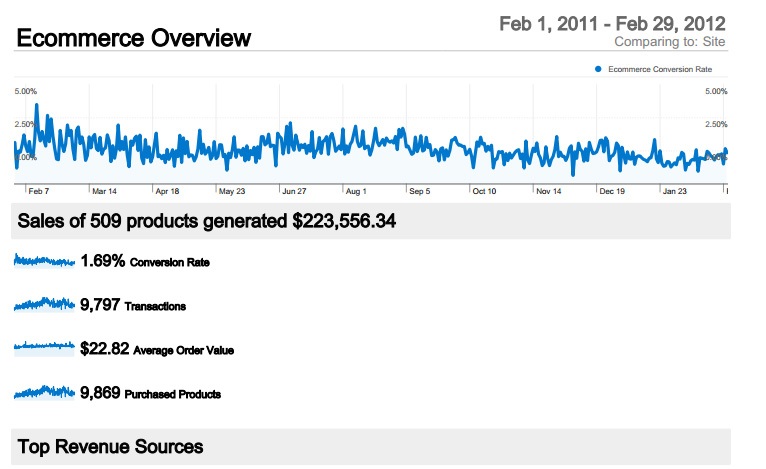
In this article, I lay out everything that you need to know to get your blog up and running today.
Whether you want to record random ruminations or leverage your blog to double your company’s profit, it’s all here.
So pull another shot of espresso.
Put on some music in the background.
Get out your pen and notepad and get ready to take some notes on this (rather extensive) article.

Why Should I Start a Blog in the First Place?
Before I tell you exactly how to start your blog and the simple steps that you can take to maximize its growth, I first need to answer one burning question.
Why in the world should you start a blog in the first place?
After all, just creating a blog will cost you a couple hundred dollars and a few hours of work, and actually scaling that same blog will likely take thousands of dollars and years of effort!
So why should you even bother?
While I could drone on for hours about why you need to be blogging and how it will affect your life and business in a positive way, at its core, blogging gives you three major benefits.
1. Blogging Improves Your Website’s Search Engine Visibility
One of the first reasons that you should start blogging is because it will improve your visibility to search engines.
Google will rarely if ever, promote a website that does not have a regularly updated blog.
As soon as you start creating and publishing content on a consistent basis, Google will begin crawling and listing your blog (especially if you learn how to do SEO properly).
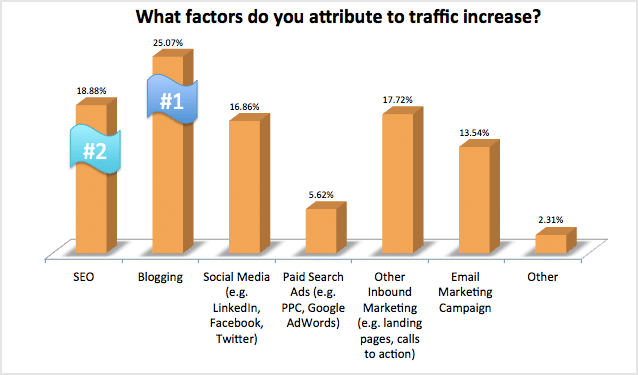
Ultimately, this will lead to new visitors and potential customers visiting your site on a daily basis.
2. Blogging Gives you a Way to Monetize Your Knowledge
If you are an expert in any given field, blogging allows you to take your expertise, package it, and sell it online.
If you leverage your blog properly, you can easily generate loads of new traffic to your website.
Monetizing a blog typically takes at least 1-2 years of upfront work before you will begin to see results.
However, once you have made your first $1 through your blog, you now know that you can make your first $100 or $1,000 or even $1,000,000.
As long as you learn the best practices and are willing to put in the work, the sky is truly the limit for what you can earn through your blog.
3. Blogging Gives You Unique Branding Opportunities
Blogging is effectively just a tool for self-branding and promotion (or business promotion).
And if you can learn to use it effectively, you will be able to use your blog’s promotional capacity to land dozens upon dozens of new opportunities.
Just think about Tim Ferriss’s four-hour blog.
His blog helped him land a book deal which helped him land a TV deal which both have helped him become an entrepreneurial icon and make millions in the process.

If you can leverage your blog effectively, the possible opportunities that will be presented to you are limitless.
The Simple 3 Step Process to Creating Your Blog
Getting your blog created and published is actually a simple process.
After reading this guide, it should take you less than 30 minutes to create and launch your blog (adding and promoting content, however, is another story).
Here are the three steps you need to follow to create an epic, blog of killer whale proportions.
Step 1: Select Your Domain and Setup Your Hosting (~15 Minutes)
The first step on your journey to creating a wildly successful (and profitable) blog is to select your domain and setup the hosting for your website.
Your domain is just the web address that people will type in to find your site. (e.g. www.moneyjournal.com)
While domains range in price from $9.99 $9,999.99 if you follow my advice, you will be able to create a killer domain name and get it for free.
But before I detail how you can do this, I want to talk about hosting.
If you were running a physical retail store, hosting would be the building where you house and sell your products.
Once you have selected your domain, it is important that you find the right company to host your website (considering that the hosting service will handle security and website backups, this is a pretty important service).
Just like your domain name, hosting is a relatively cheap expense coming in between $3-5 a month (typically purchased as an annual or two-year subscription).
If you’re just getting started, I personally recommend BlueHost for all of your web hosting needs.
In addition to stellar service and phenomenal features, BlueHost offers a free domain name with the purchase of their $2.95/month hosting service.
Here’s how to get started with your domain and hosting using BlueHost.
Head over to bluehost.com and click the giant green “Get Started” button.


Here, you are presented with two options.
#1: You can select a new domain that Bluehost will give you for free.
#2: You can host an existing domain that you purchased before signing up with Blue Host.
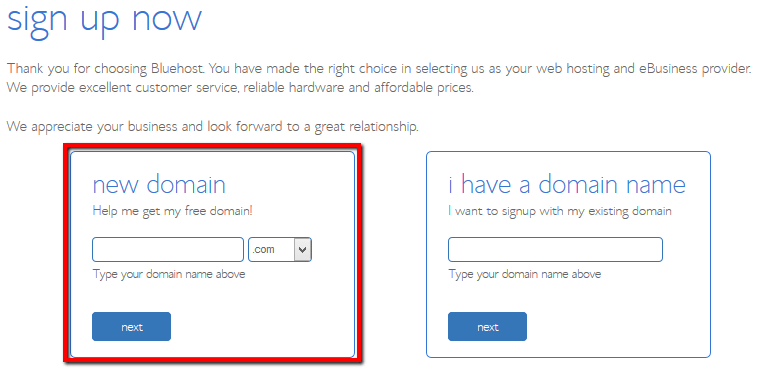
Now before we move on, we need to discuss exactly how to select the best domain name for your new blog.
Tips for Selecting a Killer Domain Name
Ten years ago, selecting a domain name was simple, easy to remember, and related to your brand or business was easy.
However, as the art of blogging becomes more and more popular (and as investors realize the value of a strong domain name) the proverbial well has started to dry.
Nowadays, finding a coherent two-word domain name for less than $1,000 is a monumental task, and unless you have a very uncommon name, it is almost certain that you will be unable to purchase yourname.com.
So does this mean that you should just throw in the towel and call the quits?
Would I have written this article if that was the case?
Even though finding and buying a good domain name is more difficult than it has ever been, it is still possible.
Here are a few simple tips to help you navigate this process and find a domain name that you love.
1. Keep it under 4 Words
Most high-quality domain names under 3 words are already taken.
However, you still want to do your best to keep your domain relatively short (preferably four words or fewer).
You will rarely find highly successful blogs with long domain names that are difficult to find and remember.
And even though there are exceptions, the world of blogging is already competitive enough, so stack the cards in your favor and keep your domain name short.
2. Eliminate Ambiguity
One big mistake that people make when selecting their blog name is that it is hard to spell or has ambiguous or repetitive wording.
For example, imagine that you are listening to a podcast episode on the Money Journal show and you hear someone mention their blog “foursimplefunnels.com”.
Hold up… Was that “Four” or “4” or even “For”?
Unless the speaker specified, you would have to test out the different variations until you found their site, and unless he had a crazy offer that you couldn’t refuse, odds are good that you would not go through the trouble.
Another common wording mistake is to create domain names with redundant spelling.
What I mean by this is that your domain contains repeated letters that the audience might not know about.
For example, something like sociallegacy.com is rarely a good idea.
Make sure that when you are selecting your domain, each word is clearly delineated.
3. Make it Memorable and Catchy
Make the name something that audiences will remember.
The internet is full of irrelevant and unmemorable blogs. Be sure that yours is something that grabs the audience’s attention.
4. Don’t Use Blog Extensions
I see lots of blogging newbies opting for domain extensions like .biz .ly and .game.
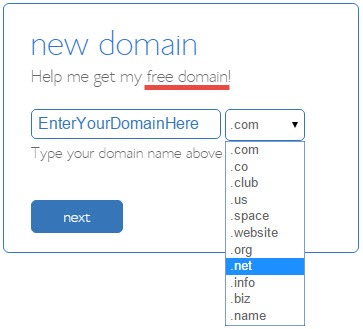
This might be a cheaper option but almost always makes your website more difficult to find.
Do yourself a favor and stick to .com (don’t even use .org unless you are actually an organization)
5. Double Check the Name’s Availability on Social Media
Social media plays a huge role in the growth and success of any online business.
And if you want to grow your blog following and eventually turn your blog into a cash generating machine, then it is important that you have access to the social media accounts associated with www.yourblog.com.
Ready to search for your blog name?
Use the tool below to get started.
Now that you have selected your domain name, it’s time to finish setting up your hosting before you install WordPress and get to blogging.
With your domain selected and approved, the next step is to fill out the contact form pictured below before reviewing and placing your order.
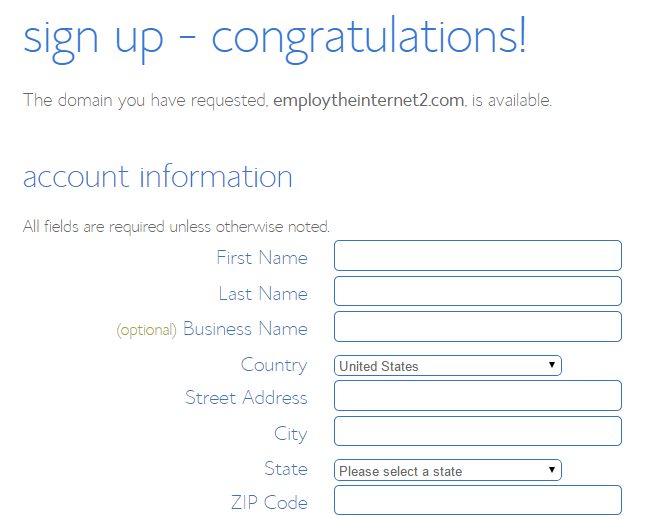
Now review your package information to double check that you are purchasing everything that you need (and nothing that you don’t).

I will be blunt here.
Most of the add-on offers are completely superfluous and unnecessary.
There is almost always a better/cheaper way to accomplish the same tasks that they are trying to charge you an exorbitant fee for.
However, there are two exceptions to this rule.
I strongly recommend that you purchase the Domain Privacy Protection and Site Backup Pro.
Domain Privacy Protection will protect you from spammers and keep your personal information out of the hands of marketers and salespeople.
Site Backup Pro is your insurance if anything ever happens to the WordPress security systems or platform.
With your domain chosen and your options selected, it’s time to pay your bill and get down to business.

Step 2: Selecting and Installing Your Website Building Platform (~10 Minutes)
Now that you have setup your domain and hosting, it is time to select a website building platform.
For about 99% of you, this is going to be a very straightforward task.
Use WordPress.
Cut and dry, plain and simple.
“Why?” you might ask.
Well, for starters, WordPress is the most widely used website platform currently in existence, with over 72 million active users and a 50.07% market share (over half the websites in existence run on WordPress).
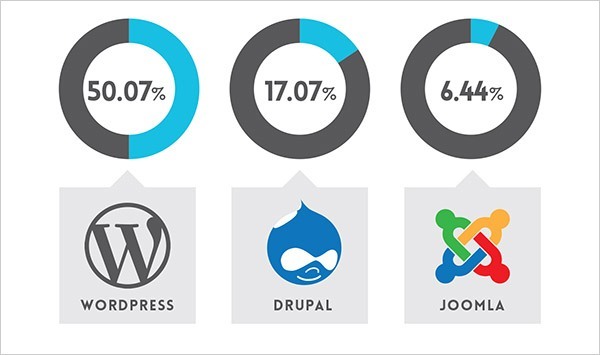
But there’s more to it than that.
1. WordPress is FREE
Yes, you read that correctly.
WordPress is totally free to download and install and comes prepackaged with hundreds of beautiful themes and tons of valuable plugins.
It doesn’t matter whether you are looking to create a blog to post up random ruminations or run the world’s next best e-commerce site, WordPress comes loaded with everything you need to crush your goals.
2. WordPress is Super Easy to Use
Unlike Drupal or Joomla (the next most popular website building platforms) WordPress is extremely easy for beginners to use.
It doesn’t matter whether you are an experienced designer or a total newbie, WordPress makes it easy to build a killer website with no previous experience.
3. WordPress is Secure
If you are creating a blog for business or eCommerce purposes, then security should be a big concern.
However, with clients like GE and Ford using WordPress’s platform, you can rest easy knowing that security is taken very seriously and it’s unlikely to ever be an issue.
4. WordPress Designs are Responsive (a.k.a Mobile Friendly)
This is HUGE.
You know how frequently I discuss the importance of responsive design here on Money Journal.
No matter what your business goals, you need to realize that mobile is the future of the internet.
This makes WordPress even more powerful since all website designs are created mobile-optimized and ready to implement.

Wondering about how to create your own plugin to solve a unique issue you are facing?
Need help figuring out how to integrate your CRM into WordPress?
You are in luck.
With the 70 million+ active users, there is a HUGE support group at your fingertips to answer all questions WordPress.
What If I REALLY Don’t Want to Use WordPress?
Despite all of my attempts to convince you of WordPress’s merits, some of you simply don’t want to use it.
And that’s ok.
As Burger King says, you can “Have it Your Way”
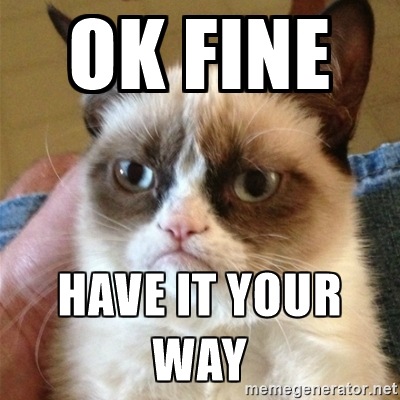
I understand this (and still recommend that you bite the proverbial bullet and use it anyways) and have compiled the five best alternatives for those of you who truly disdain WordPress.
1. Drupal:

Drupal shares almost every key functionality that WordPress does and even offers a bit more variety and customization to the savvy coder.
However, the key here is that you are a savvy coder, meaning that Drupal’s barrier to entry is quite high for those of you without a strong foundation in coding languages.
2. Joomla:

Joomla is another highly effective open source CMS that shares all of the core traits that make WordPress great, and a few that set it apart.
However, just like Drupal, Joomla requires that you have a strong coding background to fully take advantage of all that it offers.
Luckily, Joomla has a very active and engaged customer base that is always looking to help one another out.
3. Ghost:
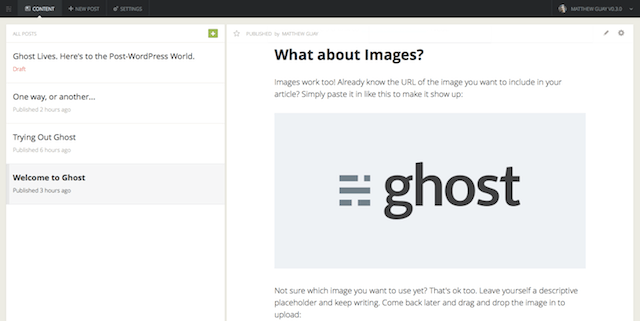
Ghost is focused entirely on the art of blogging.
Whereas WordPress is beginning to focus more on social media and eCommerce integration to help build fully functioning business websites, Ghost focuses entirely on blogging and sharing content.
This platform is spartan and minimalistic to ensure that the focus is entirely on the content you are sharing and not on the distracting bells and whistles.
4. Medium:

Medium is another popular publishing platform that differs from WordPress in a variety of ways. Namely the fact that it is designed to create a minimalistic space for the sharing and connecting with stories and ideas.
There are no plugins, and in lieu of comments, Medium offers in line notes and responses. If you are looking for the simplest way to share your ideas without much concern about SEO, or integration, Medium is a good choice.
A Quick Note About the Importance of Self Hosting
Before I end this section, I wanted to discuss a problem that I see arising with many online entrepreneur newbies.
The pervasive nature of free blogging platforms.
Places like Weebly, Blogspot, Squarespace and even WordPress.COM all appear to be great places to host your blog at first glance.
But when you dig deeper you will realize why this is such a bad idea.
1. There is No Safety in Free Web Hosting
And I mean this in every conceivable way.
Just skim through a few Google searches and you will be overwhelmed by a plethora of examples of free web hosting servers that randomly decided to shut down, decided to remove a user’s content, or were infiltrated by hackers.
If you need any proof of this, just take Yahoo Geocities and 2ip for example.
Yahoo Geocities decided to close their services in April of 2009.
They informed existing customers that their domains would remain functional even after they shut down their services to new registrants.
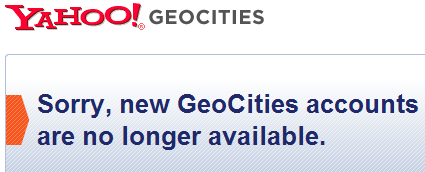
Then, they changed their tune and sent customers a message letting them know that they would be deleting their services.
Meaning that if you left any of your content on their servers after the deadline in October, it was gone… forever.
And if that seems like an unlikely anomaly, just take 2ip as another example of the problems associated with free web hosting.
2ip offered great hosting.
Well, they did, at least until they were hacked and forced to go offline because of the financial damage and stolen data.
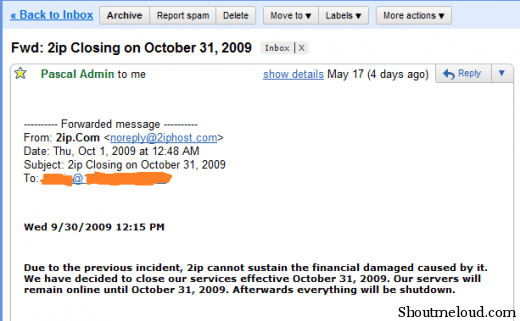
The majority of free web host providers do not allow you to use your website to advertise with Google Adwords or other services, this severely handicaps your ability to make money with your new site.
3. You Cannot Sell Your Blog
If you opt for free web hosting, then you will never be able to sell your blog once you have built up your audience and want to make an exit.
A quick perusal through the terms and conditions makes this painfully clear.
So the bottom line here?
Free web hosting will always cost you more in the long run. NEVER use it.
NEVER…
Installing WordPress on Your New Website
And now we get to the good stuff.
The following 1,500 words will provide you with all of the information that you need to successfully install and launch your very first (or second or third) blog.
1. Install WordPress
If you decide to heed my advice and use WordPress and your website’s platform, then this step is simple.
All you need to do is log in to your hosting account, go to the control panel, select the WordPress icon and the domain you want to install it to and click “install now”

Follow the instructions on screen and make sure that you save the username and password somewhere safe. You will need it in a moment.
Next, choose your blog destination (yourwebsite.com)
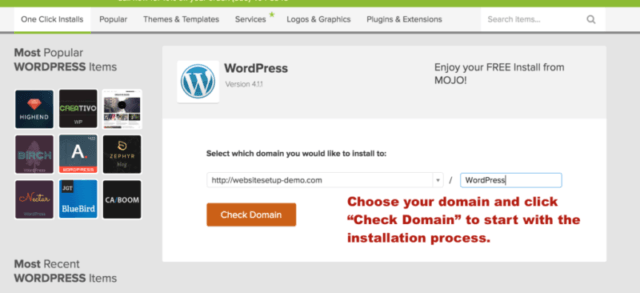
You can now visit your website by typing your domain into the search bar, however, you will be presented with something like this.

You are now ready to login to the WordPress admin panel and get started by selecting a theme/design and customizing your website.
2. Logging Into WordPress
Earlier in this article, I told you to hold onto your WordPress username and password, and here is the part where that matters.
To login to your WordPress account and get started customizing and upgrading everything, you need to go to www.yourdomain.com/wp-admin/
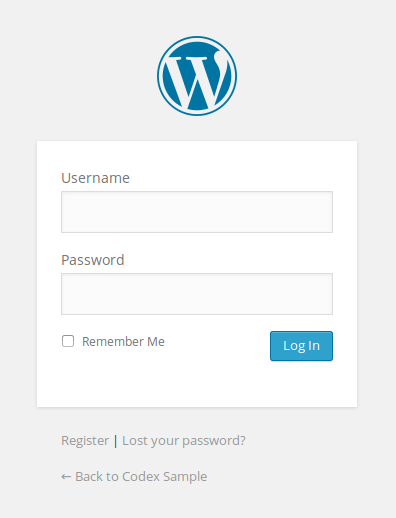
Next, input your username and password and you will be taken to a dashboard that looks like this.
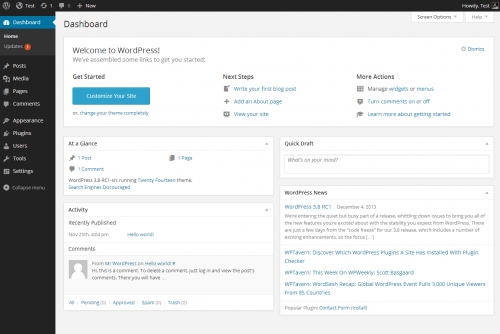
Now that you have logged into your Admin dashboard, you can select the theme for your new website from the appearance bar on the side.

You will now be able to upload new themes, see your currently installed themes, and make any changes that you wish to your website.
While WordPress comes preloaded with tons of awesome themes you can also get more premium themes at elegantthemes.com and themeforest.com.

designing a professional website here.
If you opt for a premium theme from one of these websites, you simply need to download the theme and then select “Upload Theme” from your WP Dashboard.

Remember that you can always change your theme later, but it’s best if you can find a theme that is consistent with your desired brand image from the start so that you can eliminate any updates in the future.
By now, your website is now setup and fully operational.
Of course, I am going to dive into how you can add pages, manage plugins and complete other necessary actions, but the bulk of the work in actually setting up your blog is completed.
Pat yourself on the back and give us a big smile!
Step 3: The Finishing Touches: Adding Pages, Managing Plugins, and Other Random Tidbits (~35 Minutes)
With Your WordPress website set up and ready to rock, it’s time to put the finishing touches on your blog by adding pages, posts, plugins, and shoring up a few other odds and ends.
1. How to Add Pages and Posts to Your Blog
Now that your theme has been selected, it’s important that you set up a few basic pages to ensure that your blog is user-friendly and easily navigable for new visitors.
Here’s how you create posts and pages.
From the dashboard panel, move your cursor over either “Posts” or “Pages” and from the popup menu, select add new.

When you are starting a new blog, I recommend that you include the following pages:
- Home: This is where you will have either a static front page or a revolving list of your most recent content. Tell visitors who you are and what you are about.
- About: This is all about you and your business. What do you do? Who do you help? What are your goals?
- Contact: This is for audience members who want to connect with you or your company. This can be everything from a simple contact form to including your name and phone number.
- Blog: This is where all of the most recent content that you have published should appear.
- Resources/Free Stuff: Look, if you really want to make your blog successful, then you need to offer some sort of free lead magnet to collect emails from your viewers. Include a “Free Stuff” page where you make your offer and this will be a walk in the park.
2. How to Manage Plugins (And the 5 Most Important Plugins for Blogging Success)
Plugins are essentially third-party tools that allow you to optimize your website and extend the functionality of your blog.
Here is how you upload a new plugin to your website.
Go to the dashboard, and select “Plugins”> “Add New” from the side menu.

From here you can either browse and install plugins directly from WordPress, or you can upload Plugins by uploading the .zip file from plugins that you or another third party has created.
Once you have installed a plugin, it is time to activate it.
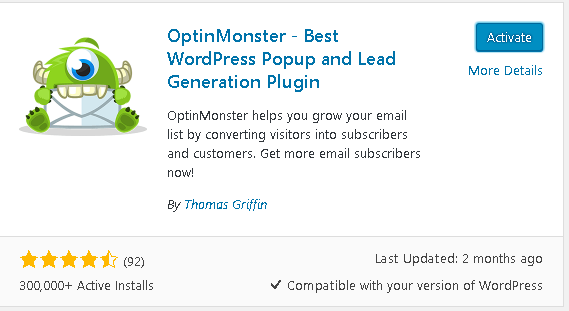
Now, unless you are required to integrate your plugin with your third party account, your plugin will be ready for use.
So now that you know how to install and activate plugins, which ones are the most important for your success as you enter the blogging world?
1. Yoast SEO
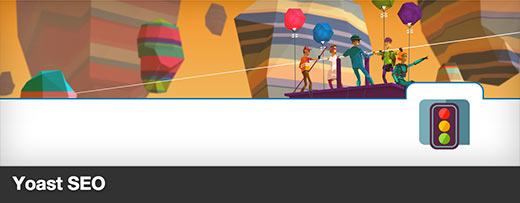
SEO is one of the most important factors in monetizing and growing your blog and the Yoast SEO plugin helps you make sure that your pages are going to be easy for search engines to crawl and rank.
It helps you optimize your entire website and is by far one of the most valuable plugins on the market.
2. Optinmonster
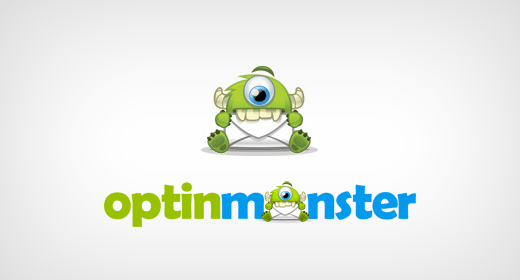
Optinmonster is a phenomenal tool for maximizing conversions on your optin forms.
If you are looking to quickly grow your email list and plug all of the proverbial “holes” in your optin forms, Optinmonster is a must have for you and your website.
3. W3 Total Cache
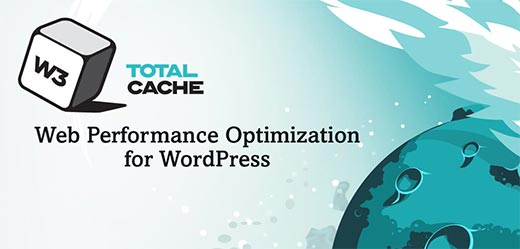
One of the keys to building a successful website is that you must feel the need… the need for Speed!

Your blog’s speed plays a huge factor in the user experience and for your Google search rankings.
W3 Total Cache allows you to reduce the load on your server and increase the website speed to guarantee your users never leave because of long load times.
4. Constant Contact
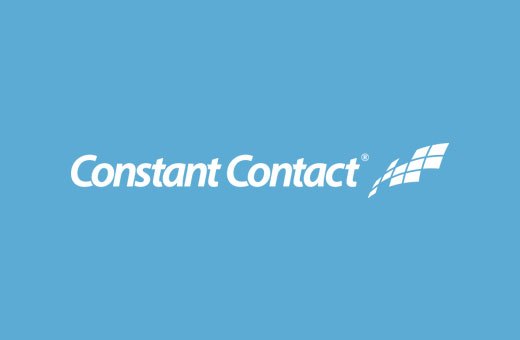
While I personally prefer email marketing platforms like Active Campaign, Constant Contact is one of the best email marketing platforms for beginners.
It is simple to use and setup and integrates seamlessly with WordPress
5. Monster Insights
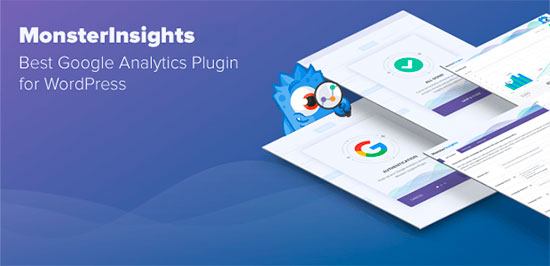
Monster Insights is one of the best plugins for using and understanding Google Analytics to maximize the results that your blog is producing.
It shows you who is coming to your website and what they are doing so that you can identify weak spots and patch them up, increasing your traffic and earnings simultaneously.
3. Other Important Tidbits
So now that you have learned how to create pages and posts, selected your theme, and installed a few handy plugins, it’s time to finish your blog setup and take care of a few final “tidbits” before you can call it done.
1. Set Up Your Links to be Google Friendly
Before you are ready to roll, you need to make sure that the permalinks on your website are setup to be as search engine friendly as possible.
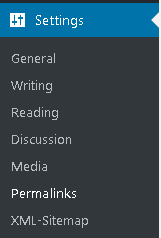
I personally recommend that you choose the setting “Post Name” as this will maximize search engine visibility.

For example, this is what your URL will look like with the “Post Name” option selected.
This will make it easier to get the green light from Yoast SEO and easily improve your search engine visibility.
2. How to Design Readable Posts
An important aspect of the user experience and search engine optimization of your blog is the readability of your posts.
In fact, if you are using Yoast SEO as recommended, you will see a small little checkbox on the right-hand side of your posts (or at the bottom with the SEO details) telling you how readable they are.

Improving the readability of your posts is easy to do and will have an immediate impact on your search engine performance.
The key is to create a sense of flow in each of your articles.
Use headings and subheadings to break up the body of your article and write short sentences that are easy to read.
Use bulleted lists and bold font to clearly separate ideas and you will be off to the races (yes it really is that simple).
3. Make Sure that You Leverage Your Links
One important aspect of SEO and a key pillar of writing good content on your blog is to be sure to take advantage of your ability to link to external and internal content.
Whether you are linking out to a study that you cited or linking back to an article you wrote last week, including these links in the body of your articles will help you build up a healthy link profile and make your content much more user-friendly.
Here’s how you do it.
Whenever you are linking out to external content, you want to be sure that all of your links open in a new tab.
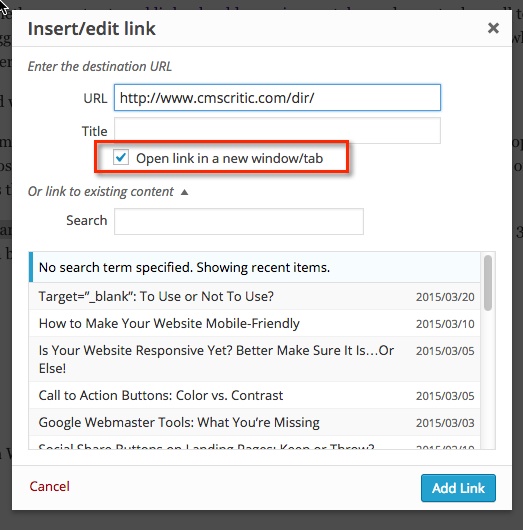
You now know everything that is required to create and scale a highly profitable blog for your personal brand or business.
Blogging is both an art and a science and it will take you years to truly master.
But if you implement the above advice and take my recommended resources to heart, you will be able to build a blog that can completely transform your business.
So get to it!
My work here is done.
Do you have any additional questions about blogging that I didn’t answer? Have you found any tactics or resources that have helped you grow your blog? Let me know in the comments below.
Original article and pictures take www.moneyjournal.com site
Комментариев нет:
Отправить комментарий